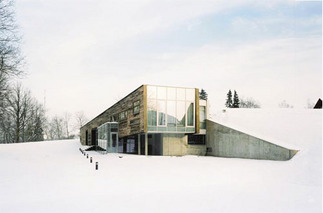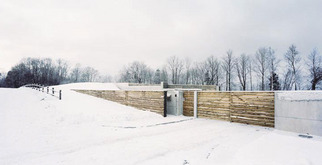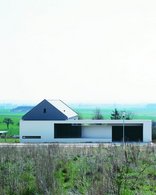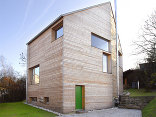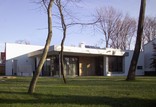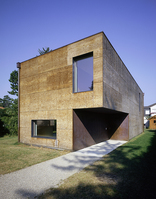Bauwerk
Privat House
ARHIS - Sigulda (LV) - 2004

Private house, Sigulda
The interaction between architect Andris Kronbergs, the clients and the natural surroundings is woven into this design.
8. Januar 2006 - Anita Antenišķe
Would it be important to you to have a visible house? For most of the people the answer would be „yes“. Not in this case, however. Largely invis-ible from the street, this private house received an award for the best architectural design in Latvia for 2004, beating all the heavyweight rivals and becoming a place of pilgrimage for both architects and the general public.
Picturesque and powerful landscapes were what sprang to the client’s mind when thinking of the primeval Gauja River valley, designated a National Park three decades ago. When he acquired a sloping site just inside the park’s borders and surrounded by traditional steep-gabled villas, his main desire was to respect the existing landscape as much as possible. It was his friend, artist Ja¯nis Borgs, who first came up with the idea of a building protruding from the hillside. He also suggested contacting architect Andris Kronbergs, who heads the ARHIS design office. Kronbergs saw the task as a great opportunity to express his own deep sensitivity for nature and passion for reticent and sincere design, both shared by the client.
The hillside on which the building sits was first excavated and then filled in again once the house was completed. The plot was strongly landscaped in bands of simple „mater-ials“: a rye field skirting the street, a grassy lane on the valley side, gravel for the cour d’honneur, and pebbles for the tourist trail that passes through the yard and across the roof of the building, which is accessible from the rye field. An open-work fence is all that separates the plot from the street, while a pebble-paved path marks the valley-facing boundary, leaving it up to architectural means rather than physical obstacles to determine the borderline between public and private space.
Add golden leaves in autumn, bird-cherry tree blossoms in spring and a mantle of white in winter for the complete shell for the building itself. A new design element was a pond filled by a natural spring that came to light during earth-moving operations.
The building is an elongated, linear structure. Orthogonal geometry provides a backbone for the skewed volumetric composition and spatial layout. Slanting, protruding and naturally uneven elements create a genuine sense of nature inside the house. A combination of rough, massive surfaces and smooth, light elements meanders through the house. Nonetheless, the details are more functional than decorative. The main sculptural accents in the interior – massive, irregularly slanting concrete columns – also play a vital structural role as counterforts for the weight of the hill resting on the long, reinforced concrete wall. At the same time, they separate the public and private areas of the house. The windows in the kitchen and living room project outwards to capture the best of the morning sun and the evening light. The architectural composition also determines the linear direction of the interior and exterior lighting.
The rooms are arranged in a linear sequence, too. A utility room at the north end of the building is followed by the car parking, entrance hall, office and dining room. Here the levels split – a few steps lead down to the living room, TV corner and sauna, while a long flight of stairs leads up to the bedrooms. All the bathrooms and utility rooms are located in a parallel sequence, between the outer hillside wall and the columns.
One of the most important features of the building is its tactility. Rough, offcut timber finish for the exterior walls makes a powerful contrast with the large windows. Waxed, but robust reinforced concrete walls, polished spruce-wood floors, felt curtains and ceiling finish in the TV corner (by interior consultant Barbara Ãbele) serve as a background for natural timber furniture and soft pillows that add to the restrained elegance and warmth of the interior. The only colour accents in this light grey interior are in the bathrooms.
In a way, the building is a contemporary interpretation of ancient Baltic traditions, a holistic and integrated residential complex ensuring the peace of the inward-orientated life of a family and sensitive interactions between man and nature. It is the slow pace of nature, like listening to grass growing, that the family is experiencing. But not for an eternity: Sigulda is a major ski resort, and the same client has commissioned a small-scale ski centre to the north of the house.
Picturesque and powerful landscapes were what sprang to the client’s mind when thinking of the primeval Gauja River valley, designated a National Park three decades ago. When he acquired a sloping site just inside the park’s borders and surrounded by traditional steep-gabled villas, his main desire was to respect the existing landscape as much as possible. It was his friend, artist Ja¯nis Borgs, who first came up with the idea of a building protruding from the hillside. He also suggested contacting architect Andris Kronbergs, who heads the ARHIS design office. Kronbergs saw the task as a great opportunity to express his own deep sensitivity for nature and passion for reticent and sincere design, both shared by the client.
The hillside on which the building sits was first excavated and then filled in again once the house was completed. The plot was strongly landscaped in bands of simple „mater-ials“: a rye field skirting the street, a grassy lane on the valley side, gravel for the cour d’honneur, and pebbles for the tourist trail that passes through the yard and across the roof of the building, which is accessible from the rye field. An open-work fence is all that separates the plot from the street, while a pebble-paved path marks the valley-facing boundary, leaving it up to architectural means rather than physical obstacles to determine the borderline between public and private space.
Add golden leaves in autumn, bird-cherry tree blossoms in spring and a mantle of white in winter for the complete shell for the building itself. A new design element was a pond filled by a natural spring that came to light during earth-moving operations.
The building is an elongated, linear structure. Orthogonal geometry provides a backbone for the skewed volumetric composition and spatial layout. Slanting, protruding and naturally uneven elements create a genuine sense of nature inside the house. A combination of rough, massive surfaces and smooth, light elements meanders through the house. Nonetheless, the details are more functional than decorative. The main sculptural accents in the interior – massive, irregularly slanting concrete columns – also play a vital structural role as counterforts for the weight of the hill resting on the long, reinforced concrete wall. At the same time, they separate the public and private areas of the house. The windows in the kitchen and living room project outwards to capture the best of the morning sun and the evening light. The architectural composition also determines the linear direction of the interior and exterior lighting.
The rooms are arranged in a linear sequence, too. A utility room at the north end of the building is followed by the car parking, entrance hall, office and dining room. Here the levels split – a few steps lead down to the living room, TV corner and sauna, while a long flight of stairs leads up to the bedrooms. All the bathrooms and utility rooms are located in a parallel sequence, between the outer hillside wall and the columns.
One of the most important features of the building is its tactility. Rough, offcut timber finish for the exterior walls makes a powerful contrast with the large windows. Waxed, but robust reinforced concrete walls, polished spruce-wood floors, felt curtains and ceiling finish in the TV corner (by interior consultant Barbara Ãbele) serve as a background for natural timber furniture and soft pillows that add to the restrained elegance and warmth of the interior. The only colour accents in this light grey interior are in the bathrooms.
In a way, the building is a contemporary interpretation of ancient Baltic traditions, a holistic and integrated residential complex ensuring the peace of the inward-orientated life of a family and sensitive interactions between man and nature. It is the slow pace of nature, like listening to grass growing, that the family is experiencing. But not for an eternity: Sigulda is a major ski resort, and the same client has commissioned a small-scale ski centre to the north of the house.
Für den Beitrag verantwortlich: A10
Ansprechpartner:in für diese Seite: Hans Ibelings
